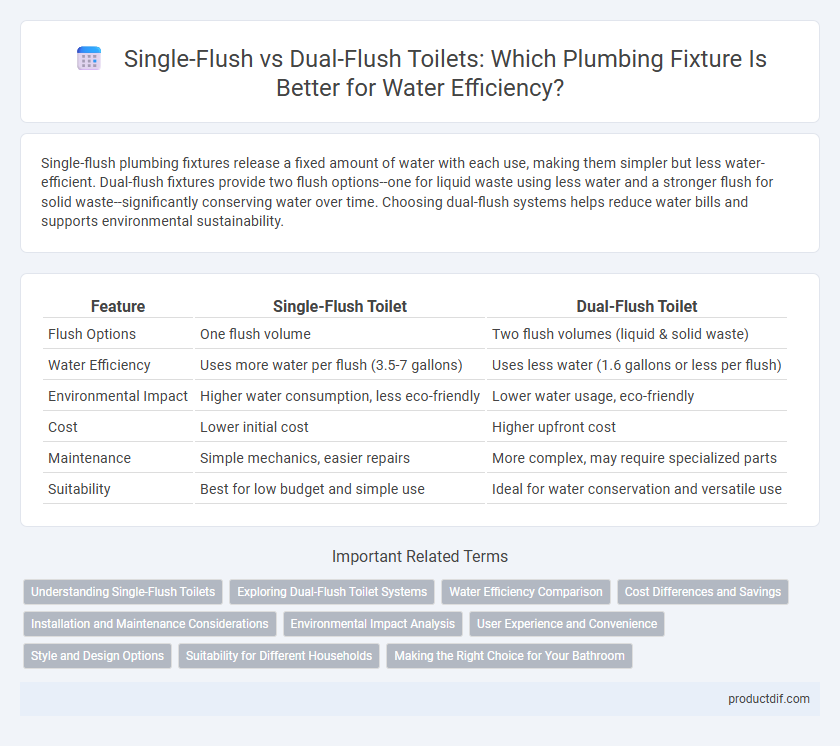Single-flush plumbing fixtures release a fixed amount of water with each use, making them simpler but less water-efficient. Dual-flush fixtures provide two flush options--one for liquid waste using less water and a stronger flush for solid waste--significantly conserving water over time. Choosing dual-flush systems helps reduce water bills and supports environmental sustainability.
Table of Comparison
| Feature | Single-Flush Toilet | Dual-Flush Toilet |
|---|---|---|
| Flush Options | One flush volume | Two flush volumes (liquid & solid waste) |
| Water Efficiency | Uses more water per flush (3.5-7 gallons) | Uses less water (1.6 gallons or less per flush) |
| Environmental Impact | Higher water consumption, less eco-friendly | Lower water usage, eco-friendly |
| Cost | Lower initial cost | Higher upfront cost |
| Maintenance | Simple mechanics, easier repairs | More complex, may require specialized parts |
| Suitability | Best for low budget and simple use | Ideal for water conservation and versatile use |
Understanding Single-Flush Toilets
Single-flush toilets use a consistent volume of water for every flush, typically around 1.6 gallons per flush (GPF), ensuring a straightforward mechanism with fewer moving parts. These fixtures are often preferred in settings where simplicity and reliability are priorities, but they consume more water compared to dual-flush models that allow separate flush options for liquid and solid waste. Understanding the water efficiency and maintenance demands of single-flush toilets is crucial for optimizing plumbing fixture choices in residential and commercial applications.
Exploring Dual-Flush Toilet Systems
Dual-flush toilet systems offer two flush options: a lower volume flush for liquid waste and a higher volume flush for solid waste, significantly reducing water consumption compared to single-flush models. These plumbing fixtures typically use around 0.8 to 1.1 gallons per flush (gpf) for light flushes and 1.6 gpf for full flushes, promoting efficient water management in residential and commercial settings. By integrating dual-flush technology, homeowners can lower utility bills and contribute to environmental sustainability through decreased water usage.
Water Efficiency Comparison
Single-flush toilets typically use 1.6 gallons (6 liters) of water per flush, while dual-flush models offer two options: a low-volume flush of 0.8 gallons (3 liters) for liquid waste and a higher-volume flush of 1.6 gallons (6 liters) for solid waste, significantly reducing overall water consumption. Dual-flush toilets can save up to 67% more water compared to single-flush models, making them a highly efficient choice for residential and commercial plumbing fixtures. Water efficiency data from the Environmental Protection Agency (EPA) estimates that switching to dual-flush toilets can save an average household up to 13,000 gallons (49,210 liters) of water annually.
Cost Differences and Savings
Single-flush toilets generally have a lower upfront cost compared to dual-flush models, making them more accessible for budget-conscious buyers. Dual-flush toilets offer significant water savings by providing options for partial or full flushes, leading to reduced water bills over time. Although dual-flush fixtures incur higher initial expenses, the long-term savings on water consumption can offset the purchase price within a few years.
Installation and Maintenance Considerations
Single-flush toilets typically feature simpler installation with fewer components, reducing the time and expertise required for setup and repairs. Dual-flush systems involve more complex mechanisms, which may demand professional installation to ensure optimal performance and water-saving benefits. Maintenance for dual-flush toilets often requires periodic adjustments or replacement of specific parts like the flush valve and button assembly to maintain efficiency.
Environmental Impact Analysis
Single-flush toilets use a consistent water volume per flush, typically around 1.6 gallons, which can lead to higher overall water consumption compared to dual-flush models that offer partial flush options. Dual-flush toilets significantly reduce water waste by allowing users to choose between a low-volume flush for liquid waste and a higher volume flush for solid waste, cutting water use by up to 67%. Environmental impact analyses show that dual-flush fixtures contribute to conserving municipal water supplies and reducing energy demands associated with water treatment and pumping.
User Experience and Convenience
Single-flush toilets offer straightforward operation with one button for an easy user experience but may waste water with every flush. Dual-flush toilets provide customizable water usage, enhancing convenience by allowing users to select a low flush for liquid waste and a full flush for solid waste, improving water efficiency. Many users find dual-flush models more eco-friendly and cost-effective over time, balancing performance and environmental impact.
Style and Design Options
Single-flush toilets offer a wide range of classic and modern style options, featuring diverse shapes, colors, and finishes that can seamlessly complement various bathroom designs. Dual-flush models emphasize sleek, contemporary aesthetics with minimalist lines and compact forms, designed to enhance both visual appeal and water efficiency. Both types provide customizable choices to suit different preferences, but dual-flush fixtures often integrate innovative design elements aligned with eco-friendly trends.
Suitability for Different Households
Single-flush toilets, which release a fixed amount of water per flush, are suitable for households with consistent water usage needs or where simplicity is preferred. Dual-flush toilets offer two flushing options--typically a half-flush for liquid waste and a full flush for solid waste--making them ideal for environmentally conscious homes aiming to reduce water consumption. Families with varying water usage patterns benefit from dual-flush systems, as they provide flexibility and potential cost savings on water bills.
Making the Right Choice for Your Bathroom
Choosing between a single-flush and dual-flush toilet hinges on water efficiency and usage habits. Single-flush toilets use a fixed amount of water per flush, making them simpler but less water-efficient compared to dual-flush models that offer separate flush options for liquid and solid waste. Opting for a dual-flush fixture can significantly reduce water consumption, aligning with eco-friendly bathroom designs and lower utility bills.
single-flush vs dual-flush Infographic

 productdif.com
productdif.com